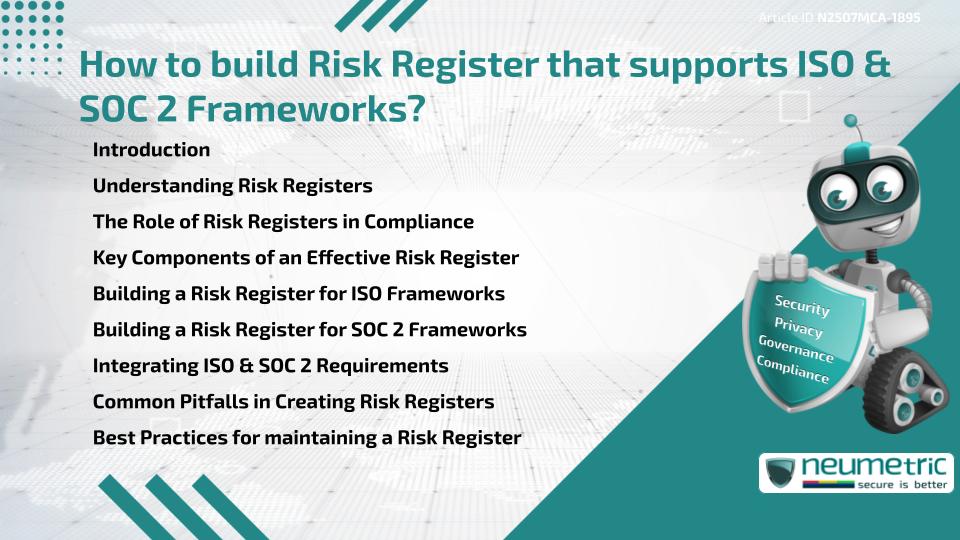Table of Contents
ToggleIntroduction
How to build Risk Register that supports ISO & SOC 2 Frameworks? This question often arises for Organisations aiming to meet both Industry Best Practices & formal Compliance Standards. A Risk Register is more than just a Spreadsheet of Threats-it is a structured tool that helps Organisations identify, evaluate & mitigate Risks while ensuring adherence to recognised frameworks like ISO 27001 & SOC 2. By combining these Frameworks, businesses can create a unified approach to Risk Management, streamline Audits & strengthen operational resilience. This article explains the essentials of Risk Registers, their role in Compliance & step-by-step guidance to create one that meets both Frameworks without duplication of effort.
Understanding Risk Registers
A Risk Register is a centralised Document or Database where potential Risks are recorded, assessed & tracked over time. It includes details like the nature of the Risk, its Likelihood, potential Impact, Mitigation measures & assigned Ownership. Think of it as a master log for your Organisation’s “what could go wrong” scenarios, combined with “what we are doing about it”.
The Role of Risk Registers in Compliance
Risk Registers serve as a bridge between Business Operations & Compliance obligations. In the ISO context-particularly ISO 27001-Risk Registers demonstrate that security Risks are systematically identified & addressed. Under SOC 2, they help prove that Controls are designed & operating effectively to safeguard Data & maintain Trust.
For example, ISO 27001 demands evidence of a formal Risk Assessment process, while SOC 2 requires demonstration of Controls that mitigate identified Risks. A well-maintained Risk Register satisfies both needs. Resources like ISO.org & AICPA detail these requirements further.
Key Components of an Effective Risk Register
To be useful & Audit-ready, a Risk Register should include:
- Risk ID & Description – Clear reference number & short explanation
- Category – Operational, Compliance, Financial or Technical Risk
- Likelihood – Probability of occurrence, often rated from low to high
- Impact – Severity of potential consequences
- Risk Owner – Person responsible for mitigation
- Mitigation Plan – Actions to reduce Likelihood or Impact
- Status – Current progress on mitigation efforts
- Review Date – Scheduled time to reassess the Risk
Building a Risk Register for ISO Frameworks
For ISO 27001, the process starts with a comprehensive Risk Assessment. This involves identifying Information Assets, analysing Potential Threats & determining Vulnerabilities. Risks should be evaluated using the organisation’s Risk Criteria, documented in the Statement of Applicability & linked to corresponding Controls in Annex A of ISO 27001.
When building the Register:
- Map each Risk to relevant ISO Controls
- Document residual Risks after mitigation
- Maintain records to show continual improvement
Building a Risk Register for SOC 2 Frameworks
For SOC 2, focus on Risks affecting the five (5) Trust Services Criteria-Security, Availability, Processing Integrity, Confidentiality & Privacy. The Risk Register should map each Risk to the corresponding Control activities & Evidence of Testing.
SOC 2 Assessments emphasise Operational effectiveness, so your Register should:
- Include Evidence collection methods
- Record Testing frequency for each Control
- Demonstrate link between Risks & SOC 2 Trust Principles
Integrating ISO & SOC 2 Requirements
Since both Frameworks overlap in their Risk Management intent, Organisations can create a single integrated Risk Register by:
- Aligning Risk Categories across Frameworks
- Cross-referencing Risks to both ISO Controls & SOC 2 Criteria
- Using a common Risk Scoring methodology
- Ensuring evidence collection supports both Audits simultaneously
This integration minimises duplication & ensures consistent Risk handling across the Organisation.
Common Pitfalls in Creating Risk Registers
Some frequent mistakes include:
- Overcomplicating Risk Scoring
- Failing to assign clear Ownership
- Not updating the Register regularly
- Treating it as a Compliance Checkbox rather than a living Document
A Risk Register that is not maintained loses value quickly & may fail in an Audit.
Best Practices for maintaining a Risk Register
- Review quarterly or after major Incidents
- Involve Stakeholders from multiple Departments
- Automate updates where possible using GRC Tools
- Keep entries concise but actionable
- Link each Risk to measurable outcomes
Takeaways
- A Risk Register is essential for demonstrating Compliance with both ISO 27001 & SOC 2.
- Integration reduces duplication & increases efficiency.
- Proper structuring, ownership & regular updates are key to effectiveness.
FAQ
What is the purpose of a Risk Register?
It helps Organisations systematically identify, assess & manage Risks while providing a clear record for Compliance & Operational decisions.
How often should a Risk Register be updated?
At least quarterly or after any significant operational change or incident.
Can one Risk Register cover both ISO & SOC 2?
Yes, if designed with aligned Categories, Control mapping & shared Evidence requirements.
What happens if a Risk Register is incomplete?
It can undermine Compliance efforts, weaken Security Posture & lead to Audit failures.
Need help for Security, Privacy, Governance & VAPT?
Neumetric provides organisations the necessary help to achieve their Cybersecurity, Compliance, Governance, Privacy, Certifications & Pentesting needs.
Organisations & Businesses, specifically those which provide SaaS & AI Solutions in the Fintech, BFSI & other regulated sectors, usually need a Cybersecurity Partner for meeting & maintaining the ongoing Security & Privacy needs & requirements of their Enterprise Clients & Privacy conscious Customers.
SOC 2, ISO 27001, ISO 42001, NIST, HIPAA, HECVAT, EU GDPR are some of the Frameworks that are served by Fusion – a SaaS, multimodular, multitenant, centralised, automated, Cybersecurity & Compliance Management system.
Neumetric also provides Expert Services for technical security which covers VAPT for Web Applications, APIs, iOS & Android Mobile Apps, Security Testing for AWS & other Cloud Environments & Cloud Infrastructure & other similar scopes.
Reach out to us by Email or filling out the Contact Form…


